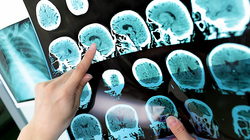
Types of Multiple Sclerosis
There are six types of Multiple Sclerosis
Each type has a variable beginning and
progression course.
For most, this progression cycle generally happens
over the various courses of the disease.
Important to know is that everyone has their own
variety of symptoms and progression path
******************************************************************************************************
85% of patients begins with a diagnosis of Relapse Remitting MS. RRMS is characterized by relapses (also called flares or exacerbations), during which symptoms of MS worsen or new symptoms appear. Between relapses, a person with RRMS has periods when symptoms are stable or progress slowly.
The other 15% start in later stages with a diagnosis of Secondary Progressive or Primary Progressive.
This is most likelybecause their diagnosis came later in their progressive cycle. It's not uncommon
for patients to acquire the disease early in life, generally 16+ yrs of age. Perhaps their early symptoms went undetected because they were so minor and simply blended in with the other age specific hormonal changes that occurred.
In any case, being diagnosed as early as possible and immediately taking disease modifying drugs can slow further progression. Plus Neurologists are much better at identifying and understanding the symptoms of MS. Especially in the last few years. While we wait for a cure, slowing disease progression medications are currently what is available. The reality is once you progress and lose functionality the likelihood of regaining what you have lost is generally not possible . However with the current range of symptom management drugs it's very possible that patients can at least have an interim coping method for cognitive distress and to better handle physical pain or limitations.
There are six types of Multiple Sclerosis
Each type has a variable beginning and
progression course.
For most, this progression cycle generally happens
over the various courses of the disease.
Important to know is that everyone has their own
variety of symptoms and progression path
******************************************************************************************************
85% of patients begins with a diagnosis of Relapse Remitting MS. RRMS is characterized by relapses (also called flares or exacerbations), during which symptoms of MS worsen or new symptoms appear. Between relapses, a person with RRMS has periods when symptoms are stable or progress slowly.
The other 15% start in later stages with a diagnosis of Secondary Progressive or Primary Progressive.
This is most likelybecause their diagnosis came later in their progressive cycle. It's not uncommon
for patients to acquire the disease early in life, generally 16+ yrs of age. Perhaps their early symptoms went undetected because they were so minor and simply blended in with the other age specific hormonal changes that occurred.
In any case, being diagnosed as early as possible and immediately taking disease modifying drugs can slow further progression. Plus Neurologists are much better at identifying and understanding the symptoms of MS. Especially in the last few years. While we wait for a cure, slowing disease progression medications are currently what is available. The reality is once you progress and lose functionality the likelihood of regaining what you have lost is generally not possible . However with the current range of symptom management drugs it's very possible that patients can at least have an interim coping method for cognitive distress and to better handle physical pain or limitations.

Understanding the Transition
Between Relapsing-Remitting MS
and Secondary-Progressive MS
http://www.everydayhealth.com/multiple-sclerosis/understanding-the-transition-between-relapsing-remitting-ms-and-secondary-progressive-ms/
Types of Multiple Sclerosis
* Relapsing-Remitting (RRMS)
http://www.nationalmssociety.org/about-multiple-sclerosis/relapsing-ms/relapsing-remitting-ms-rrms/index.aspx
* Progressive Relapsing (PRMS)
http://www.nationalmssociety.org/about-multiple-sclerosis/progressive-ms/progressive-relapsing-ms/index.aspx
* Primary Progressive (PPMS)
http://www.nationalmssociety.org/about-multiple-sclerosis/progressive-ms/primary-progressive-ms/index.aspx
* Secondary Progressive (SPMS)
http://www.nationalmssociety.org/about-multiple-sclerosis/progressive-ms/secondary-progressive-ms/index.aspx
* Clinical Isolated Syndrome (CIS)
http://www.nationalmssociety.org/about-multiple-sclerosis/what-we-know-about-ms/diagnosing-ms/cis/index.aspx
*TumaFactive Multiple Sclerosis (TFMS)
http://www.medlink.com/medlinkcontent.asp
Website:
http://www.msactivesource.com/typesms.xutm/campaign=FormSpecific&utm_source=google&utm_medium=cpc&utm_content=RRMS&utm_term=relapsing%20remitting%20multiple%20sclerosis
http://www.nationalmssociety.org/about-multiple-sclerosis/relapsing-ms/relapsing-remitting-ms-rrms/index.aspx
* Progressive Relapsing (PRMS)
http://www.nationalmssociety.org/about-multiple-sclerosis/progressive-ms/progressive-relapsing-ms/index.aspx
* Primary Progressive (PPMS)
http://www.nationalmssociety.org/about-multiple-sclerosis/progressive-ms/primary-progressive-ms/index.aspx
* Secondary Progressive (SPMS)
http://www.nationalmssociety.org/about-multiple-sclerosis/progressive-ms/secondary-progressive-ms/index.aspx
* Clinical Isolated Syndrome (CIS)
http://www.nationalmssociety.org/about-multiple-sclerosis/what-we-know-about-ms/diagnosing-ms/cis/index.aspx
*TumaFactive Multiple Sclerosis (TFMS)
http://www.medlink.com/medlinkcontent.asp
Website:
http://www.msactivesource.com/typesms.xutm/campaign=FormSpecific&utm_source=google&utm_medium=cpc&utm_content=RRMS&utm_term=relapsing%20remitting%20multiple%20sclerosis

8 Ways to Improve Your Quality of Life with MS
https://mail.google.com/mail/u/0/?hl=en&shva=1#inbox/13ff7a1313684620
https://mail.google.com/mail/u/0/?hl=en&shva=1#inbox/13ff7a1313684620
HealthlineConnect to Better Health
Website:
http://www.healthline.com/health-blogs/perspectives-in-ms/stages-of-ms
Exacerbations
http://www.nationalmssociety.org/about-multiple-sclerosis/what-we-know-about-ms/treatments/exacerbations/index.aspx
*Unraveling the mystery of MS with big data
http://wwwmsviewsandrelatednews.blogspot.com/2012/12/unraveling-mystery-of-multiple.html
*Newly detected is Chiari, a disease similar to MS
National Institute of Neurological Disorders and Stroke
What is Chiari Malformation? Chiari malformations (CMs) are structural defects in the cerebellum, the part of the brain that controls balance. When the indented bony space at the lower rear of the skull is smaller than normal, the cerebellum and brainstem can be pushed downward. The resulting pressure on the cerebellum can block the flow of cerebrospinal fluid (the liquid that surrounds and protects the brain and spinal cord) and can cause a range of symptoms including dizziness, muscle weakness, numbness, vision problems, headache, and problems with balance and coordination. There are three primary types of CM. The most common is Type I, which may not cause symptoms and is often found by accident during an examination for another condition. Type II (also called Arnold-Chiari malformation) is usually accompanied by a myelomeningocele-a form of spina bifida that occurs when the spinal canal and backbone do not close before birth, causing the spinal cord to protrude through an opening in the back. This can cause partial or complete paralysis below the spinal opening. Type III is the most serious form of CM, and causes severe neurological defects. Other conditions sometimes associated with CM include hydrocephalus, syringomyelia, and spinal curvature.
